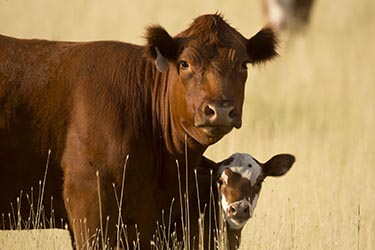Spring calving and disease prevention

Preparing your herd for spring calving
As producers prepare for spring calving, your veterinarian is a valuable source of information for vaccination schedules, herd health management planning, nutritional recommendations and staff training.
General herd management practices
Start with a breeding soundness exam on each bull mid-March to evaluate reproductive organs and semen quality. Test new breeding bulls for trichomoniasis prior to purchase. Checking the body condition scores of breeding cows can be time-intensive, but your veterinarian can be a great resource, both as extra pairs of hands and eyes, and to train your staff how to visually score the herd.
While ongoing evaluation is important, Dr. Rick Rasby of the University of Nebraska-Lincoln writes, “The greatest single factor influencing rebreeding performance of beef cows is body condition at calving, especially for spring-calving females. However, if producers wait until calving to manage body condition of their cows, they will find it very difficult and expensive to increase the body condition of a lactating cow.”
Make sure to remain vigilant for proper sanitation, environmental management and adequate nutrition to avoid scours. If scours are observed within the herd, work with your veterinary staff to implement Sandhills Calving System protocols to develop strategies for control and prevention.
Feeding and vaccination considerations
Don’t wait until disease breaks out to vaccinate your herd. A sound prevention program will cost less over the long-term and will protect your investment. Work with your veterinarian to determine the best vaccination schedule, dosage requirements, proper storage and administration method for your herd.
Calves are recommended to receive these vaccines prior to weaning:
- Blackleg 7-Way
- IBR-BVD-P13
- Leptospirosis
- Brucellosis
Heifers should be vaccinated for Brucellosis at 4-12 months. It is recommended that pregnant cows receive the Scours vaccine. Prior to breeding, they also should receive:
- IBR
- BVD-P13
- BRSV
- Vibriosis
- Leptospirosis
- Blackleg 7-Way
Cows and bulls should receive these vaccines annually, with Vibriosis and an optional Trichomoniasis given 30-60 days prior to breeding.
- IBR
- BVD
- P13
- BRSV
- Leptospirosis (5-Way)
- Vibriosis
As part of your pasture management program, add magnesium oxide to the diet if your area is prone to grass tetany. Late spring to early summer, treat for horn flies.
Justifying the cost of vaccinations, herd health management plans and veterinary care may seem to be difficult. But your vet is the best resource to ensure your herd remains healthy, and profitable, for years to come.
For vaccinations and nutritionals for your herd, contact your sales representative at 855.724.3461 or online.
Sources:
https://beef.unl.edu/learning/condition1a.shtml
https://beef.unl.edu/beef-production-calendar
https://beef.unl.edu/beefreports/symp-2007-17-xx.shtml
https://www.drovers.com/article/beef-cattle-herd-health-vaccination-schedule
https://extension.tennessee.edu/publications/Documents/W419.pdf
Careers
Are you looking for a place to let your talents shine? At Covetrus, we help our practitioner customers better serve their patients and take pride in providing the best customer experience possible. Search our open positions to see our available opportunities.
Newsletter
Stay current with what’s going on with Covetrus, subscribe to receive our newsletter and email communications. Subscribers will receive the latest information in practice management, sales and marketing, animal health, and more.

